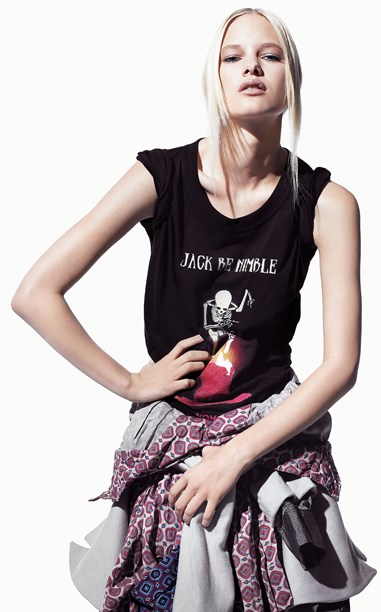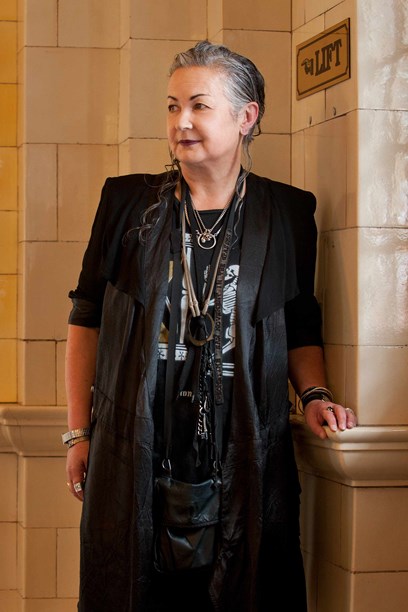Stories
NOM*d
1986-

Like many women of her generation NOM*d’s creative director, Margarita Robertson learnt to sew, knit, style, and customise garments at home, rather than through formal training.
Born in Clyde, Central Otago, in 1953 Margarita is the third eldest and first New Zealand-born child of immigrant parents, a Russian-born Greek mother and a Ukranian father, Zinovia and Peter Gladiadis. Shortly after she was born, the family moved to Dunedin and Zinovia Gladiadis, an accomplished seamstress, found work in Dunedin’s garment manufacturing industry. At home Margarita remembers her mother encouraged her and her siblings to sew. Like her elder sister Elisabeth Findlay, founder of the Auckland-based Zambesi label, Margarita’s journey to creating a top New Zealand fashion label has evolved intuitively. It was a love of clothes, a penchant for op shopping and fabric bargains and an inability to find the high-end labels she liked to wear in local stores, rather than a premeditated career choice, that propelled Margarita into the fashion industry.
In 1975, Margarita with her husband Chris Robertson, established the boutique Hang-Ups (1975-1981); at the time they were the only Dunedin stockists of the Australian label Jag. In 1979, the couple opened Plume. NOM*d was born when the Caroline Sills knitwear brand carried by Plume began to expand its range of stockists throughout the South Island and Margarita saw an opening to create her own more exclusive line of knitwear. Dunedin’s climate and the close proximity of yarn suppliers Roslyn Woollen Mills made knitwear a logical choice.
The first NOM*d collection comprised 10 womenswear styles and, from the start, a summer and winter knitwear range was created. Trips to Japan in the 1980s were a seminal design inspiration for Margarita, who admired the utilitarian approach of Rei Kawakubo (Comme des Garçons), Yohji Yamamoto and Issey Miyake, as well as their use of a limited, predominantly black, colour palette. The Japanese inflections in NOM*d led to the inclusion of an outfit from Quiet Revolution (A-W 1999-2000) in the exhibition Tokyo Vogue (Griffith University, Queensland College of Art, Brisbane, 28 October – 4 December 1999). Tokyo Vogue compared the work of Kawakubo, Miyake and Yamamoto with nine Australian and two New Zealand design houses, NOM*d and Zambesi.
Quiet Revolution was aptly named, as it marked a new direction for NOM*d with the addition of wovens alongside knitwear. The decision to expand into wovens was made in order to develop NOM*d’s export market into Australia. This collection, which reworked women’s bowling skirts, was shown when the now legendary 'New Zealand Four' (NOM*d, Zambesi, Karen Walker and World) debuted at London Fashion Week, February 1999.

Selection for the 1999 London Fashion Week prompted NOM*d designer Margarita Robertson to extend her knitwear label to include woven garments. Image © NOM*d.
Since its inception, NOM*d has built upon eight consistent design tactics – which locates the label as part of the international movement known as conceptual fashion, a movement identified with Kawakubo and Yamamoto, and European designers like Belgian, Martin Margiela. The tactics are: constructivism, vintage and reappropriation, multiple-possibility garments, bricolage, street-wear conventions, the androgynous bulky body, an anti-consumer aesthetic in a consumer environment and a self-consciousness and reflexivity, which is the primary tactic to which the previous seven tactics defer (Radner and Smith).
Margarita carefully combines international conceptual design conventions with local references. Items such as vintage fur coats worn inside out and featuring hand-stencilled Cyrillic lettering, Red (A-W 2003) and the ‘Vintage Half-Dress’ Dunedin (S-S 2002-03), a reconstructed home-sewn vintage dress front with a viscose knit back, draw a number of these concepts together exemplifying the tactics of vintage recycling and reappropriation, bricolage (putting different pieces of garments together to make a new garment), and an anti-consumer aesthetic. These tactics reflect the ‘make-do and mend’ mindset, which is part of the op shopping fraternity and Dunedin’s tertiary student population colloquially known as Scarfies. Other Scarfie inspired items include Nana-style tied dyed petticoats worn as outerwear and coats and shirts resembling academic regalia.
In 2001 the Robertsons' elder son Sam joined NOM*d as a graphic artist and is primarily responsible for the stencilled and screen-printed t-shirts produced for each season’s collection. Sam’s t-shirts reference Dunedin’s sub-cultural vibe, a product of the city’s student culture, underground music and creative scenes.

Screen-printed t-shirt designed by Sam Robertson. Image © NOM*d.
Margarita’s conceptual challenge to the systems and structures of the world of fashion extends beyond her design philosophy to eschewing the traditional runway format of the fashion show. Margarita frequently uses short film to showcase her collections, aligning her creative practice with that of film makers such as collaborators Kirsty Cameron and Richard Shaw. Many of the films can be viewed online.
At New Zealand Fashion Week, 2010, Danse Macabre (A-W 2011) was presented as an installation that brought the social chaos wrought by the Black Death into a contemporary setting. One of the consequences of the Black Death was the collapse of social boundaries and manners, Danse Macabre included a group of dinner guests sitting around a table and acting out a scene of over indulgence, including one guest spitting meringue onto another guest. On another level the installation also functioned to critique the fashion industry. The food industry has a cycle of relentless consumption: we make food, it is consumed, we clean up, and we begin again. In this context the Danse Macabre installation became an allegory for, and critique of, the fashion system’s own inexorable cycle of newness and obsolescence.

Margarita Robertson in 2011. Image © Margarita Robertson.
Although Margarita’s work received celebrity endorsement when Kelly Osborne bought a vintage half-dress in London, she is a typical fashion conceptualist, shunning the celebrity status accorded to, and courted by, fashion designers. Notwithstanding this desire to keep a low profile, Margarita’s design aesthetic has a cult following in her hometown. Ask a well-dressed Dunedin woman what she is wearing, and she is likely to reply: "NOM*d – of course!" Over the years, NOM*d has nurtured the talents of a number of young up-and-coming designers including Otago Polytechnic graduate Sarah Munro (nee Aspinall), who worked for NOM*d from 2001-2007 and now runs her own Dunedin-based conceptual fashion label Company of Strangers.
Margarita’s loyalty to the Dunedin community extends to her involvement with iD Dunedin Fashion Week as both a judge of the Emerging Designer Awards and a participant in the Railway Station Show. Her designs have also been used to promote the annual fashion festival. In addition to this, Margarita’s influence can be seen locally in the graduation collections presented by fashion students from the Otago Polytechnic School of Design, and in entries in the Hokonui Fashion Design Awards. NOM*d’s design legacy has also filtered down to a younger generation of New Zealand designers, such as Auckland-based James Dobson of the label Jimmy D.
Fashion Quarterly editorials regularly include NOM*d designs. Other national magazines to feature the work of NOM*d include Simply You, Pavement and Lucire. In April 2009, Harper’s Bazaar (Australia) included ‘Sleeveless Trench’, Bedlam (A-W 2009) in a pirate-themed shopping feature alongside the work of Vivienne Westwood, and the label Marc by Marc Jacobs. In 2005 Margarita received an invitation to exhibit at the prestigious Tranoi fashion trade fair as part of Paris Fashion Week. She has also shown in New York.
While NOM*d’s global presence highlights an international following, Margarita’s status as a national designer of significant cultural importance is recognised in public collections and by her inclusion in recent exhibitions, biographies and histories on New Zealand fashion. The Museum of New Zealand Te Papa Tongarewa purchased key pieces from Clarion (A-W 2002), the collection showcased at the inaugural New Zealand Fashion Week (2001). These pieces were included in the exhibition The First New Zealand Fashion Week (The Museum of New Zealand Te Papa Tongarewa, September 2002-2003). In 2008, the National Gallery of Victoria Foundation purchased items from NOM*d’s 21st anniversary collection ('XXI', A-W 2008); these garments, along with other NOM*d pieces were included in Together Alone: Australian and New Zealand Fashion, (National Gallery of Victoria, Melbourne, 1 October 2009 – 18 April 2010). In 2011 NOM*d was the subject of a national exhibition co-curated by Natalie Smith and Hilary Radner NOM*d: The Art of Fashion, (Eastern Southland Gallery, Gore, in association with the Eastern Southland Gallery, Gore and the Centre for Research on National Identity, University of Otago, 28 July – 2 September 2011; Whangarei Art Museum, Whangarei, 1 February -28 March 2012).
Given the significant impact that NOM*d has made on the New Zealand fashion scene, questions have been asked as to what the future holds. Margarita acknowledges that this is something she has thought about, but given the intuitive evolution of NOM*d she is happy to see what happens next. In a 2008 interview with North and South magazine she told Rebecca Tansley: "My only point of reference is Vivienne Westwood or Karl Lagerfeld. If those characters are still going, then there’s no reason to think we can’t do the same. That’s how I’d like to see it," (Rebecca Tansley, 'Dark Queen of Fashion', North and South, March 2008).
Text by Natalie Smith. Banner image © NOM*d.
Last published August 2014.